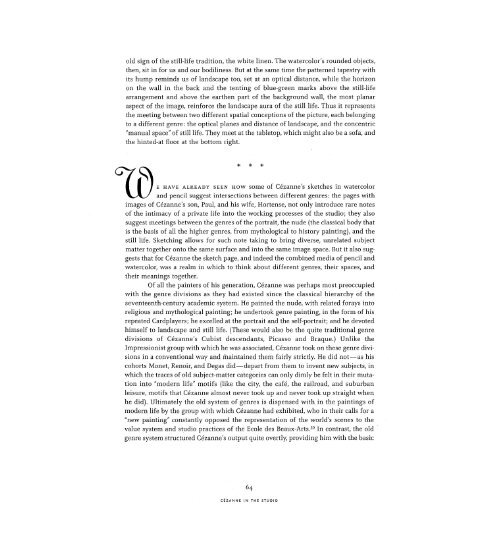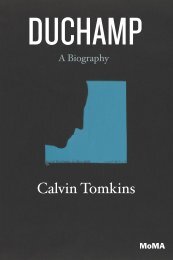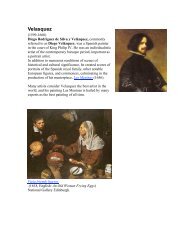Still Life in Watercolors
qbj8dgc
qbj8dgc
- No tags were found...
Create successful ePaper yourself
Turn your PDF publications into a flip-book with our unique Google optimized e-Paper software.
old sign of the still-life tradition, the white l<strong>in</strong>en. The watercolor's rounded objects,<br />
then, sit <strong>in</strong> for us and our bodil<strong>in</strong>ess. But at the same time the patterned tapestry with<br />
its hump rem<strong>in</strong>ds us of landscape too, set at an optical distance, while the horizon<br />
on the wall <strong>in</strong> the back and the tent<strong>in</strong>g of blue-green marks above the still-life<br />
arrangement and above the earthen part of the background wall, the most planar<br />
aspect of the image, re<strong>in</strong>force the landscape aura of the still life. Thus it represents<br />
the meet<strong>in</strong>g between two different spatial conceptions of the picture, each belong<strong>in</strong>g<br />
to a different genre: the optical planes and distance of landscape, and the concentric<br />
"manual space" of still life. They meet at the tabletop, which might also be a sofa, and<br />
the h<strong>in</strong>ted-at floor at the bottom right.<br />
wE HAVE ALREADY SEEN HOW some of Cezanne's sketches <strong>in</strong> watercolor<br />
and pencil suggest <strong>in</strong>tersections between different genres: the pages with<br />
images of Cezanne's son, Paul, and his wife, Hortense, not only <strong>in</strong>troduce rare notes<br />
of the <strong>in</strong>timacy of a private life <strong>in</strong>to the work<strong>in</strong>g processes of the studio; they also<br />
suggest meet<strong>in</strong>gs between the genres of the portrait, the nude (the classical body that<br />
is the basis of all the higher genres, from mythological to history pa<strong>in</strong>t<strong>in</strong>g), and the<br />
still life. Sketch<strong>in</strong>g allows for such note tak<strong>in</strong>g to br<strong>in</strong>g diverse, unrelated subject<br />
matter together onto the same surface and <strong>in</strong>to the same image space. But it also suggests<br />
that for Cézanne the sketch page, and <strong>in</strong>deed the comb<strong>in</strong>ed media of pencil and<br />
watercolor, was a realm <strong>in</strong> which to th<strong>in</strong>k about different genres, their spaces, and<br />
their mean<strong>in</strong>gs together.<br />
Of all the pa<strong>in</strong>ters of his generation, Cézanne was perhaps most preoccupied<br />
with the genre divisions as they had existed s<strong>in</strong>ce the classical hierarchy of the<br />
seventeenth-century academic system. He pa<strong>in</strong>ted the nude, with related forays <strong>in</strong>to<br />
religious and mythological pa<strong>in</strong>t<strong>in</strong>g; he undertook genre pa<strong>in</strong>t<strong>in</strong>g, <strong>in</strong> the form of his<br />
repeated Cardplayers; he excelled at the portrait and the self-portrait; and he devoted<br />
himself to landscape and still life. (These would also be the quite traditional genre<br />
divisions of Cezanne's Cubist descendants, Picasso and Braque.) Unlike the<br />
Impressionist group with which he was associated, Cézanne took on these genre divisions<br />
<strong>in</strong> a conventional way and ma<strong>in</strong>ta<strong>in</strong>ed them fairly strictly. He did not—as his<br />
cohorts Monet, Renoir, and Degas did—depart from them to <strong>in</strong>vent new subjects, <strong>in</strong><br />
which the traces of old subject-matter categories can only dimly be felt <strong>in</strong> their mutation<br />
<strong>in</strong>to "modern life" motifs (like the city, the café, the railroad, and suburban<br />
leisure, motifs that Cézanne almost never took up and never took up straight when<br />
he did). Ultimately the old system of genres is dispensed with <strong>in</strong> the pa<strong>in</strong>t<strong>in</strong>gs of<br />
modern life by the group with which Cézanne had exhibited, who <strong>in</strong> their calls for a<br />
"new pa<strong>in</strong>t<strong>in</strong>g" constantly opposed the representation of the world's scenes to the<br />
value system and studio practices of the Ecole des Beaux-Arts. 20 In contrast, the old<br />
genre system structured Cezanne's output quite overtly, provid<strong>in</strong>g him with the basic<br />
6 4<br />
CÉZANNE IN THE STUDIO




